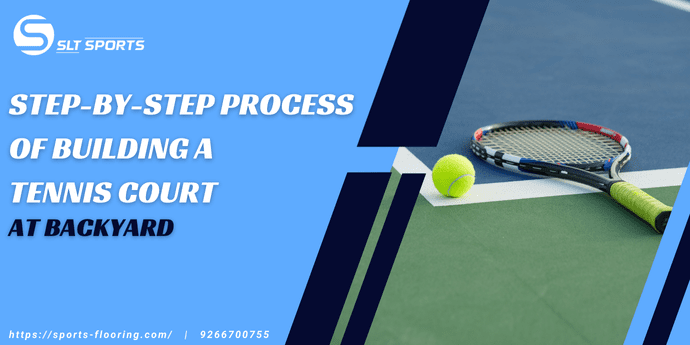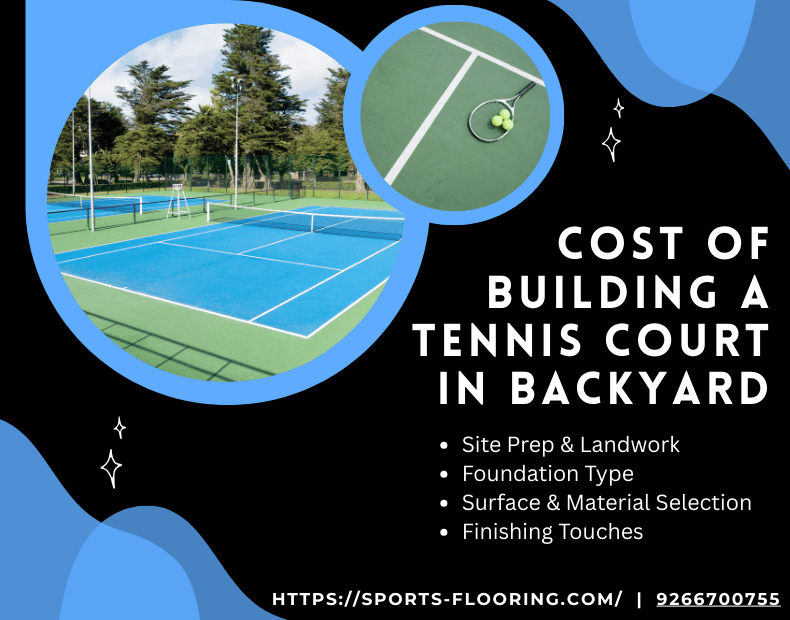
Many homeowners, sports fans and institutions dream of having a backyard tennis court. It’s not just about having a place to play, but a lifestyle where fitness, recreation and convenience come together. With today’s high quality backyard tennis court flooring, certified tennis court builders and trusted tennis court construction companies this dream can become a reality. A private tennis court adds to your property, saves you hours of commuting to clubs and gives your family a safe dedicated space to practice.
This guide will cover tennis court construction cost, flooring options, tennis court base construction, resurfacing and long term maintenance. By the end you’ll know how to plan, build and maintain a backyard tennis court that will last for years.
The Advantage of Private Tennis Court
Having your own tennis court turns your home into a sports palace. You can play whenever you want without worrying about scheduling times or court availability. Imagine finishing work and stepping onto your own court. This unbeatable convenience is a big draw for serious players and families who value fitness.
The appeal also extends to property value. A home with a professionally built tennis court stands out in the market and attracts premium buyers who see it as a lifestyle upgrade and long term investment. Plus, private courts can be designed for more than just tennis. With blended lines and smart planning one surface can also be pickleball, basketball, it’s a true multi sport area. In short a backyard tennis court flooring is more than a playfield, it’s an investment in health, family time and real estate value.
Understanding Your Backyard Tennis Court Area
Before we start building, you need to check your backyard. That’s where professional tennis court builders come in. A court needs more than space, it needs the right direction, drainage and preparation.
- Site Assessment: The land should be level with engineering methods. Slopes, soft soil or uneven ground need to be corrected during tennis court base construction. Without a solid base even the best tennis court surface material won’t perform.
- Court Direction: Courts are usually north–south to lower sun glare during matches. This little detail can make all the difference between a frustrating experience and fun play.
- Drainage: Proper slope design around 1% is the key point to channel rainwater away. Without drainage water collects on the surface, cracks, slippery spots and faster wear and tear.
Take the time to build your site and your investment will last longer and perform like a pro.
Choosing the Right Tennis Court Flooring
The surface of your tennis court is the most important part of the whole project. The choice of tennis court flooring controls play speed, maintenance and comfort. Here are the options explained in detail:
- Acrylic Hard Court Systems
Acrylic is the gold standard for backyard and professional tennis courts. Multiple layers of acrylic over asphalt or concrete produces a smooth, durable and vibrant finish. Consistent ball bounce, slip resistance and UV protection. Acrylic allows customization in color and cushion options so you can have a tennis court that meets the professionals. - Synthetic Acrylic & Cushioned Systems
If comfort is your priority, cushioned acrylic is the way to go. Special cushion layers beneath the acrylic topcoats lessen stress on joints and minimizes exhaustion during long matches. Families and older players will love this system as it allows longer playing sessions with less risk of injury. - Modular or Interlocking Tiles
Some homeowners choose modular tiles because of quick installation and low maintenance. Damaged tiles can be replaced one by one making maintenance easier. However, tiles may lack the consistency in bounce that acrylic or concrete systems offer which can affect competitive play. - Asphalt Tennis Court Construction
Asphalt is a popular foundation material because it’s affordable and quick to install. It works well with acrylic surfacing but is given to cracking over time especially in hot temperatures. Resurfacing is required to maintain performance. - Premium Options
High end acrylic brands used in professional tournaments provide the best quality. These systems are designed for international play and are the best tennis hard court material but comes at a higher cost.
Your choice of tennis court surface material should fit your budget, playing style and long term expectations.
Tennis Court Cost Break Down: What Affects Pricing?
The first question homeowners ask is: how much does it cost to build a tennis court? The cost varies greatly depending on site preparation, base type, surface and accessories.
- Site Prep & Landwork
Land that needs to be leveled or has drainage systems needs more cost. But it’s worth it as it makes sure the court lasts. - Foundation Type
Asphalt tennis court construction is cheaper upfront but cracks and needs more resurfacing. Concrete, especially post-tensioned concrete, is more expensive upfront but lasts a lifetime with minimal maintenance. - Surface & Material Selection
Premium tennis hard court surface material like acrylic with cushioning is more expensive but resurfaces less often. Modular tiles are cheaper upfront but needs more replacements over time. - Finishing Touches
Essential add-ons like fencing and lighting can add up to the cost to build a tennis court in the backyard. But they’re not optional if you want a fully functional, safe and enjoyable facility.
Ultimately, the tennis court construction cost is a long term investment. Spend wisely upfront and you won’t need to renovate later.
Working with Expert Tennis Court Builders
No matter how much planning you do, the outcome of your backyard tennis court flooring depends on the tennis court builder you choose. Professional tennis court builders have years of experience, knowledge of climate specific challenges and access to certified products.
Working with a specialist tennis court construction company means:
- Your tennis court base is engineered to prevent cracks and drainage issues.
- Only certified tennis court resurfacing products and top grade flooring systems are used.
- International standards are followed for line markings, surface smoothness and player safety.
- Post installation services such as tennis court resurfacing near me and tennis court repair near me are available if needed.
Choosing an expert means your court will last longer and you’ll spend less on repairs and get top quality play for years.

Why Choose SLT Sports for Your Tennis Court?
In sports flooring industry there are many tennis court companies are there, who offer synthetic acrylic materials. But what makes SLT Sports a premier choice is as follows:-
1. Nation-wide Support
SLT Sports installs high performance tennis court flooring everywhere in India. With third party installers and dealers supports, SLT Sports leads sports flooring industry.
2. Top Class Tennis Court Flooring
Here at SLT Sports, we offer synthetic acrylic materials for backyard tennis court flooring. And expert tennis court installation for professional grade performance, and with high durability and playability.
3. Customized Tennis Court Colors
SLT Sports offers customized color options for different sports facilities, Whether its tennis court, pickleball, badminton, or multipurpose court. We have premium tennis court colors shades, so you can build tennis court according to your choice.
4. Low Maintenance Tennis Court
SLT offers synthetic acrylic tennis court flooring is bright and long lasting. With robust tennis court materials that can withstand heavy use and all weather conditions.
5. Precision That Lasts
Our focus on precision sports court flooring installation means the surface looks great and performs consistently over time, minimizes maintenance and maximizes playability.
Why Should You Have a Backyard Tennis Court
- Total Flexibility: Play whenever you want whether its early morning, weekends or late night under the lights.
- Health & Lifestyle: Tennis is one of the best sports for cardiovascular fitness, coordination and endurance. A personal tennis court means consistent physical activity and a healthier life.
- Reconnect with Family: Sports bring people together. A backyard tennis court is a hub for family bonding, fun competition and even community gatherings.
- Increased Property Value: Homes with private courts built by professional tennis court builders like SLT Sports offers more values. Buyers see the luxury and convenience of having a personal sports facility.
- Long Term Savings
While many wonder how much does it cost to build a tennis court, the savings on club memberships, travel time and rental fees add up quickly. Over time the court pays for itself.
Backyard Tennis Court Maintenance
Your backyard tennis court’s success depends on maintenance. Regular maintenance keeps the surface safe, clean and functional.
- Cleaning: Remove leaves, dirt and debris regularly to protect the surface.
- Early Repairs: Fix cracks or wear before they become major damage.
- Protective Coatings: Use UV resistant coatings to prevent sun damage and fading.
- Scheduled Resurfacing: Refresh the surface with professional tennis court resurfacing every 5-7 years.
- Professional Check-ups: Work with tennis court installation companies for inspections and minor repairs.
With proper care your backyard court will last for decades and your initial investment will continue to pay off year after year.
Conclusion
A backyard tennis court is not a luxury, it’s an investment in health, family and property value. From tennis court base construction to the final acrylic layers, every step requires precision, quality materials and professional expertise. With trusted tennis court construction companies like SLT Sports, you can have a surface that’s durable, beautiful and built to international standards.
While the cost to build a tennis court may seem high, the long term benefits of convenience, fitness and savings far outweigh the initial cost. Regular tennis court resurfacing, timely repairs and smart maintenance will have your court looking like new for generations to enjoy. A well built court is more than just a surface, it’s a statement of lifestyle, a hub of wellness and a feature that adds value to your property for years to come.
Frequently Asked Questions
To build a tennis court in your backyard, start with the right site selection and leveling of the ground. A concrete or asphalt base is usually laid first, followed by a synthetic acrylic surface for consistent bounce and durability.
The cheapest way to build a tennis court is to use an existing flat area like a driveway or backyard slab and resurface it with acrylic paint and basic line markings. This avoids the cost of laying a new base.
Clay courts are considered the hardest surface to play on, not because of ball speed but because of physical demand.
Acrylic hard courts are the cheapest home tennis court option. They require less maintenance than grass or clay and provide a professional grade surface at a lower cost.
The standard playing area of a tennis court is 78 feet by 36 feet. For recreational backyard use many homeowners reduce the clear run off area but ideally you need at least 120 feet by 60 feet for safe play and proper movement around the court.
The cost to build a tennis court depends on location, materials and add-ons like fencing or lighting.

